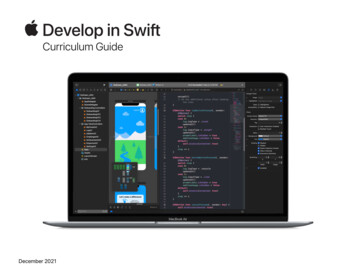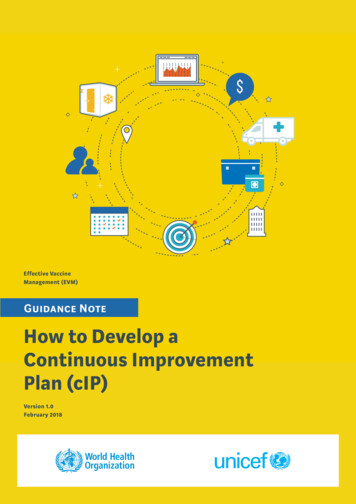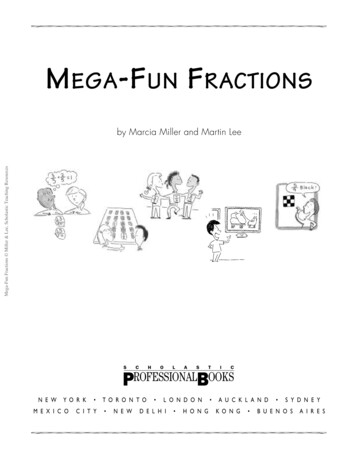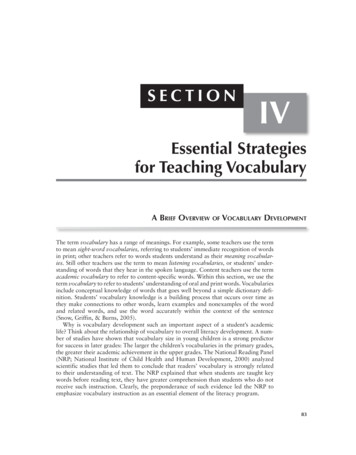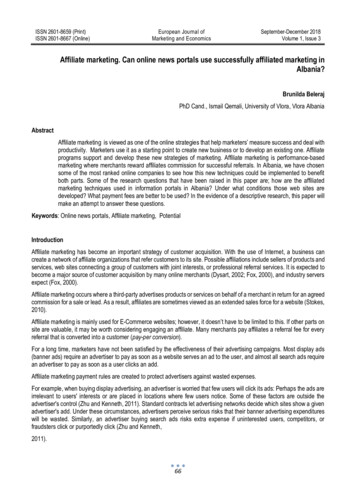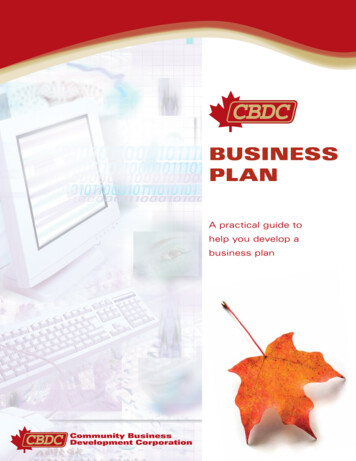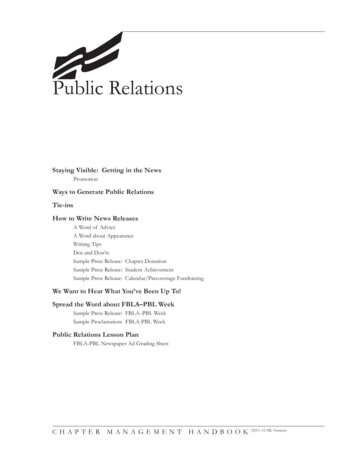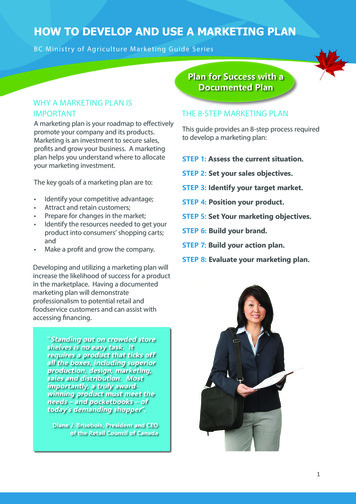
Transcription
HOW TO DEVELOP AND USE A MARKETING PLANBC Minis tr y of Agriculture Marketing Guide SeriesPlan for Success with aDocumented PlanWHY A MARKETING PLAN ISIMPORTANTA marketing plan is your roadmap to effectivelypromote your company and its products.Marketing is an investment to secure sales,profits and grow your business. A marketingplan helps you understand where to allocateyour marketing investment.The key goals of a marketing plan are to: Identify your competitive advantage;Attract and retain customers;Prepare for changes in the market;Identify the resources needed to get yourproduct into consumers’ shopping carts;andMake a profit and grow the company.Developing and utilizing a marketing plan willincrease the likelihood of success for a productin the marketplace. Having a documentedmarketing plan will demonstrateprofessionalism to potential retail andfoodservice customers and can assist withaccessing financing.THE 8-STEP MARKETING PLANThis guide provides an 8-step process requiredto develop a marketing plan:STEP 1: Assess the current situation.STEP 2: Set your sales objectives.STEP 3: Identify your target market.STEP 4: Position your product.STEP 5: Set Your marketing objectives.STEP 6: Build your brand.STEP 7: Build your action plan.STEP 8: Evaluate your marketing plan.“Standing out on crowded storeshelves is no easy task. Itrequires a product that ticks offall the boxes, including superiorproduction, design, marketing,sales and distribution. Mostimportantly, a truly awardwinning product must meet theneeds – and pocketbooks – oftoday’s demanding shopper”.Diane J. Brisebois, President and CEOof the Retail Council of Canada1
HOW TO DEVELOP AND USE A MARKETING PLANBC Minis tr y of Agriculture Marketing Guide SeriesUnderstanding theMarketplace is CrtiticalSTEP 1: ASSESS THE CURRENT SITUATIONThe first step in the development of amarketing plan is to assess the current marketsituation to provide insight into the sectorand what it takes to compete. Assessing thecurrent situation examines areas that are bothinternal to a company and external issuesaffecting it. An assessment includes:1. Reviewing your business goals;2. Identifying;a. Market drivers and consumer trends;b. Buyer trends;c. The competitive landscape;3. Conducting Market Research;4. Conducting a SWOT analysis (Strengths,Weaknesses, Opportunities and Threats).Unlike trends that last for extended periods,fads are short term bursts of enthusiasm forcertain products or diets that do not last long.Examples include the Atkins diet, deep friedeverything and the bacon craze. While it isgreat to cash in on a fad, it is best to plan forsteady, long term growth by focusing on thetrends on which you can deliver.Grocery and foodservicebuyers look for products thatare ‘on trend’.When assessing market drivers and trends, keyquestions to ask are:REVIEW OF COMPANY BUSINESS GOALS A marketing plan must be consistent with yourbusiness goals. In other words, it mustcontribute to your company’s short and longerterm goals for growth and profitability.MARKET DRIVERS AND TRENDSIt is critical for companies to understand thefactors driving the marketplace for agrifoodand seafood products and the resultingconsumer and product trends. What factors have caused longer termchanges in the agrifood and seafoodindustry? (e.g. aging population)What are the key consumer concernsaffecting food choices? (e.g. rising rate ofobesity)What key trends are occurring indemographics, consumer behaviour,products, shopping? (e.g. Millennial’s use ofsocial media and mobile technology)Are there any emerging trends? (e.g.managing food waste)A market driver is a factor that results in atrend. Consumer or product trends arepurchasing or usage behaviours that continuefor an extended period of time. For example,food safety and transparency are pressingdrivers in the food sector and will continue forthe foreseeable future. The buy local,traceability and clear labelling trends are adirect result of those drivers.2
HOW TO DEVELOP AND USE A MARKETING PLANBC Minis tr y of Agriculture Marketing Guide SeriesThere is AlwaysCompetitionBUYER TRENDSUnderstanding the buyer is just as important asunderstanding the consumer and thecompetition. Buyers include distributors,retailers and foodservice operators.Competition is fierce in the grocery sector.There is only so much room on the shelf. Youmust differentiate your product from yourcompetition in order to secure shelf space.Food retailers and foodservice operators arealso seeking to differentiate themselves fromtheir competition. They accomplish this bysupporting products and developingrelationships with suppliers that help themdeliver on consumer trends.The average grocery storecontains about 36,000 SKUs (stockkeeping units or products). If anew product is accepted, anotherwill need to go.Key questions to research about the buyer’scompany are: What changes are happening in the retailand foodservice sectors in the marketplaceof interest?What is their point of difference?How do they compete?What are their relationships with otheragrifood and seafood companies?What consumer segment are theytargeting?How can you help them meet the needs oftheir consumers?THE COMPETITIVE LANDSCAPEWhile many agrifood and seafood companiesbelieve their product to be unique, it isimportant to remember that there is ALWAYScompetition. View it from the eyes of theconsumer. With few exceptions, consumershave other options to satisfy their need ordesire. For instance, a consumer looking for ahigh protein snack has the option ofpurchasing smoked salmon, cheese or peanuts.Recognizing and understanding thecompetition is a key element of your marketingplan.Key questions to research regarding thecompetitive landscape include: What are the competitive products andwho are the companies producing them?(competitive products are those thatprovide the same benefit as your product,for example a high protein snack)What are the key benefits of thecompetitive products?What are the perceived competitiveadvantages of your competitors?What are the retail prices of the competitiveproducts?What are the product/company’s strengthsand weaknesses in the marketplace?How do your competitors communicate toconsumers and use social media?What is their omnichannel approach tosales?Omnichannel is the consistentpresentation of your productacross multiple channels(i.e. shopping online, by phoneor in a physical store).3
HOW TO DEVELOP AND USE A MARKETING PLANBC Minis tr y of Agriculture Marketing Guide SeriesMarket ResearchIdentifies OpportunitiesCONDUCTING MARKET RESEARCHMarket research must be conducted to answerquestions about market drivers, trends and thecompetitive landscape. Market research willhelp you make informed decisions and ensureyour marketing plan is based on knowledge,not speculation.For further information on market research,please see the Ministry of Agriculture’s on“How to Conduct and Use MarketResearch” guide.Market research is a process of gathering andanalyzing information to gain anunderstanding of the changing marketplacein which your product competes. The processincludes: Setting marketing research objectives;Gathering information;Analyzing the information; andUtilizing market research in developing astrategic market plan.Market research provides insight required to: Understand your target market and theirpreferences;Identify opportunities for sustainable salesand growth;Recognize market shifts;Monitor the competition; andMitigate risk in business decision-making.Base your marketing plan onknowledge not speculation.4
HOW TO DEVELOP AND USE A MARKETING PLANBC Minis tr y of Agriculture Marketing Guide SeriesSWOT Analysis Core Business ToolSWOT ANALYSISSWOT stands for Strengths, Weaknesses,Opportunities and Threats. The SWOT analysisis a core business tool and can be used as thefoundation of a competitive marketingstrategy.The most effective way for a company toconduct a SWOT analysis is to list key strengths,weaknesses, opportunities and threats in atable as outlined below.The key elements of a SWOT analysis are theidentified internal strengths and weakness ofthe company and its product(s) and theexternal opportunities and threats that do, orcould, affect your business.STRENGTHSINTERNALWEAKNESSESCapabilities, resources or attributes thatprovide a competitive advantageCapabilities, resources or attributes that needimprovementExamples: production capacity, industryexperience, financial resources, uniqueingredients or packagingExamples: lack of resources, limited experience,no marketing paln, no food safety or es that if capitalized on could have Circumstances that do or could have a negativeimpact on the businessEXTERNAL a positive impact on the businessExamples: favourable market trends, newtechnology, government policy changes,potential partnershipsExamples: regulatory changes, new trends,access to ingredients, exchange ratefluctuationsThe purpose of a SWOT is to identify thepositive characteristics of your business, themarket and the real and potential problemsthat need to be recognized and/or addressed.The SWOT analysis is a core business tool. Itshould be reviewed and updated at least on asemi-annual basis and whenevercircumstances for the business change.To use the information in your SWOT tablefocus on the strengths to addressweaknesses so that you can minimize therisks of the threats and take advantageof the opportunities.For further information on a SWOT analysis, seethe Ministry of Agriculture’s “How to Conductand Use a SWOT Analysis” guide.5
HOW TO DEVELOP AND USE A MARKETING PLANBC Minis tr y of Agriculture Marketing Guide SeriesFocus on YourTarget MarketSTEP 2: SET SALES OBJECTIVESSet sales objectives to project the amount ofsales you want to achieve over a period of time.STEP 3: IDENTIFY YOUR TARGETMARKETFollow the S.M.A.R.T. approach when settingobjectives. Each objective should be:The first step in identifying your target marketis to identify the various market segments anddetermine which one best matches thebenefits your product offers. Segmentationdivides a large market into smaller groups ofconsumers who have common needs orcharacteristics such as: SpecificMeasurableAchievableRelevantTimelyExamples of specific, measureable and timelysales objectives for a fictitious Company XYZare:Short term: Reach sales of 15,000 per monthin twelve months.Long term: Attain annual sales of 3 million inthree years.When setting sales objectives in the agrifoodand seafood sectors take into consideration theebbs and flows of grocery sales during the year.This is particularly important if your product isin higher demand during specific times of theyear (e.g. turkeys at Thanksgiving).Sales objectives may be revised during thecourse of developing the marketing plan asnew information is identified. Review salesobjectives at regular intervals (e.g. every threemonths) and make adjustments as necessary.Tip Demographic; Gender, age, income, education,household size;Psychographic; Lifestyle, personality, shared values;Geographic; andBehavioural.You may want to target more than one marketsegment. For example a food companymarketing a ready-to-eat nutritious meal atretail may target Generation Xers with children(demographic) whose household has limitedtime for healthy meal preparations (lifestyle).The better you can define your target market,the easier it is to identify the retail orfoodservice operators best suited for yourproduct.Include S.M.A.R.T. salesobjectives in yourmarketing plan so that youhave measurable objectivesto evaluate your progress.6
HOW TO DEVELOP AND USE A MARKETING PLANBC Minis tr y of Agriculture Marketing Guide SeriesPositioning MapsIdentify OpportunitiesSTEP 4: POSITION YOUR PRODUCTUnderstanding how to position a productinvolves: HIGHCALORIESA positioning map; andA positioning statement.WHAT IS A POSITIONING MAP?A positioning map is a diagram that allowsyou to compare your product to thecompetition and identify opportunities fornew products in the marketplace.A positioning map plots two key productbenefits on horizontal and vertical axes of agraph. These product benefits are basedon what is important to the consumer.Product benefits may be real or perceived andinclude calorie content, healthy ingredients,locally produced, price, protein content, etc.The following diagram provides an exampleof a positioning map that identifies a gap inthe market and an opportunity for a low price,low calorie ORIESA positioning map allows you to compareyour product to the competition andidentifies opportunities for new products inthe marketplace. It also lays the foundationfor your positioning statement which willguide your marketing efforts.For more information, see the Ministry ofAgriculture’s “How to Develop and Use aPositioning Map” guide.TipUse unbiased marketresearch when developingyour positioning map.7
HOW TO DEVELOP AND USE A MARKETING PLANBC Minis tr y of Agriculture Marketing Guide SeriesWhat Does YourProduct Deliver?WHAT IS A POSITIONING STATEMENT?A positioning statement, also known as a valueproposition, provides a concise descriptionof your product’s unique value to your targetmarket in relation to the competition. Yourpositioning statement guides your marketingefforts by helping you articulate your valueproposition, in other words, your product’suniqueness.Information to Include in Your PositioningStatement: The target market;Who is searching for;Your product brand and category;Product attributes or benefits; andReason for purchasing.Key questions to ask: What is the core value of my company andproduct?How does my product meet the keybenefits sought by the consumer?Who is the competition?What does my product deliver better thanthe competition?STEP 5: SET YOUR MARKETINGOBJECTIVESMarketing objectives are different than salesobjectives. Sales objectives representspecific monetary values while marketingobjectives lay out how the sales objectives willbe achieved.Examples of marketing objectives are:An example of a positioning statement forCompany XYZ that produces an energy bar forthe endurance athlete might be:For the endurance athlete who islooking for new sources of energy fortheir adventures, Company XYZ offersits Go Wild line of energy bars. Each GoWild bar is great tasting, high in proteinand high in calories. Using all naturalherbs and spices to add great flavour,Go Wild is ranked the best tastingenergy bar on the market bylong-distance backpackers and cyclists.Go Wild appeals to athletes who valuethe outdoors and natural foods thatrequire no preparation. Increase new customer purchases by 80%with a repeat purchase of 60% byDecember 201X;Retain 70% of customers who areMillennials with children by July 201X; andIncrease e-commerce customersacquisition 30% by December 201X.TipRemember the S.M.A.R.T.approach when settingobjectives.8
HOW TO DEVELOP AND USE A MARKETING PLANBC Minis tr y of Agriculture Marketing Guide SeriesYour Brand isYour PromiseSTEP 6: BUILD YOUR BRANDWHAT IS A BRAND?STEPS IN BUILDING A BRANDA brand represents a consumer’s experiencewith a product. Your brand is a promise youmake to your consumers that strengthens theirloyalty so that they will continue to chooseyour product over others. The emotionalconnection consumers have with your productis often what keeps them coming back. Yourbrand’s job is to continually build thatconnection between your company and yourtarget market.Building an effective brand can be aninvigorating experience. Build your brand by:Think of a brand in terms of the consumer. Abrand represents all that a consumer thinks ofwhen hearing or seeing the brand name.WHAT IS BRANDING?Branding creates a clear and compellingidentity for a company and its product. Itpromotes values, transparency and benefits inwhich consumers can believe and identify.The goals of building a brand are to: Build a relationship with the consumer;Increase sales;Secure higher prices;Turn your consumers into advocates havethem endorse your product and brand toother consumers and social networks; andLeverage the brand when introducing newproducts. Knowing your loyal target market;Developing your brand promise basedon what sets your product apart from thecompetition;Building your story that resonates withbuyers and consumers; andCommunicating your brand consistently.Key questions to ask: What are my company’s core values?How do I want my target market to viewmy company and product line?What emotions do I want to evoke in mycustomers when they see my product orhear the brand name?Is my brand name meaningful to mytarget market?Can branding be used effectively acrossall channels (print media, websites, socialmedia)?For more information on branding, see theMinistry of Agriculture’s “How to Develop aStrong Brand for Your Product” guide.9
HOW TO DEVELOP AND USE A MARKETING PLANBC Minis tr y of Agriculture Marketing Guide SeriesDifferentiateYour ProductSTEP 7: BUILD YOUR ACTION PLANSteps 1 through 6 focus on the foundationupon which to build the action-orientedsection of the marketing plan. Your action plan,Step 7, addresses the target market’s keypurchasing requirements in areas of the ‘4 Psof Marketing’ – Product, Price, Place andPromotion. The purpose of your action planis to document how you will get your producton the shelf and into the shopping carts ofconsumers.Key questions to ask: Do I have a food safety and traceabilityprogram in place?Is my packaging eye-catching?Does my packaging maximize the space ona pallet and a shelf?Does the nutritional labelling meetregulatory requirements?Is the name/brand registered? (seeCanadian Intellectual Property Office)PRODUCTYour product is more than what is contained inthe package. In general, an agrifood orseafood product encompasses: Your product has less than 3seconds to attract the eye of theconsumer.The brand: must resonate with theconsumer and be protectable (trademark);The consumable: taste, quality, productattributes, consistency from one tasteexperience to the next, shelf-life;The package: eye-catching, protects fromcontamination and breakage, providesinformation (labelling, nutrition facts, howto use);Customer service: responsive to buyersand consumers, a recall plan; andFood safety and traceability programs: forthe food item and packaging.you are planning onyour product inTip Ifexportingthe future, you must alsoconsider how the productname and/or brandtranslate into otherlanguages.10
HOW TO DEVELOP AND USE A MARKETING PLANBC Minis tr y of Agriculture Marketing Guide SeriesPricing is aCritical DecisionPRICEDetermining the ‘right’ price is a majordecision. Regardless if your product targetsthe retail or foodservice sectors, the keyconsideration is ‘margin’ and is usuallyexpressed in terms of a percentage.MARGIN PERCENTAGE PROFIT/PRICE (PRICE-COST)/PRICESmall agrifood and seafood companies haveno control over the margins buyers take or theshelf price. Buyers however expect companiesto provide a suggested price. A price must: Be competitive;Cover costs; andContribute to the growth of your company.StrategyCost Based PricingBreak-Even PricingCompetitive-Based PricingCustomer-Based PricingPremium/Value Based Pricing Regardless if you are selling to a distributor,retailer or foodservice company, there areoften many ‘hidden costs’ that must befactored into your pricing. Examples includelisting fees, cash discounts, damaged goods,product liability insurance and promotionalallowances.PRICING STRATEGIESThe following table provides an overview ofthe various strategies for consideration. Keepin mind that the most appropriate pricingstrategy for a product or product line istypically a blend of these strategies.DescriptionCosts profit priceProvides minimum pricing to break even (cover costs)Set price based on competitors’ pricePrice based on customers’ willingness to paySet price to differentiate based on higher perceivedquality or special featuresKey questions to ask: HIDDEN COSTS IN PRICINGWhat are the true costs of making yourproduct and getting it on the shelf?Are you manufacturing and distributingyour product as efficiently as possible?Can you make a profit that contributes tothe growth of the company?Selling retail and direct-to-consumer?You are putting your relationship with yourretailer at risk if you sell the same productdirectly to the consumer at a lower price.Your direct-to-consumer price should besimilar to the retail price or you shoulddifferentiate your product so the consumersees it as a different product. For examplemake a 6-pack for retail and a 10-pack foronline sales.For more information on pricing, see theMinistry of Agriculture’s “How to Determinethe Right Retail Price for Your Product” and“How to Sell Your Product to a Retailer” guides.11
HOW TO DEVELOP AND USE A MARKETING PLANBC Minis tr y of Agriculture Marketing Guide SeriesSell Where YourCustomers ShopPLACE‘Place’ refers to the location where yourproduct can be purchased and how it will bedistributed.The key to identifying the best place to sellyour product depends on where your targetmarket shops and how they shop. Forexample, a high-end specialty product isbetter placed in a store offering thoseproducts rather than one that caters to pricesensitive consumers. As well, if theproduct targets the tech savvy generation,Millennials, then availability throughe-commerce will be critical.Agrifood and seafood companies areincreasingly developing an omnichannelapproach to ‘Place’, providing consumersdifferent ways in which they can purchase theproduct.ENTRY STRATEGIES‘Place’ also considers the options for marketentry. Will you use a distributor or broker ordeal directly with the buyer or consumer? Thefollowing table outlines the possible pathwaysand identifies the key advantages anddisadvantages of ect to BuyerCompany sells direct to aretail or foodservice buyerHigher return oninvestmentMore latitude on settingpricesDirect contact with buyersNo services or access toexperience of brokers ordistributorsMay take longerDistributorTakes ownership of theproductOffers services such assoliciting orders, customerservice, stocking inventory,delivering products andcarrying receivablesRepresents many productsNeed to ensure you havethe production capacityto fill larger quantities ifdemandedCan be difficult to get on adistributor’s listBrokerActs as your sales agentSales and marketingservicesProvides market, industryand strategic adviceWorks with distributorsYour product is one ofmanyYou need to look afterdistribution and paymentDirect to ConsumerE-commerceSelling onlineReduced overhead costsShipping and logistics canbe challenging12
HOW TO DEVELOP AND USE A MARKETING PLANBC Minis tr y of Agriculture Marketing Guide SeriesRead the Fine PrintSPECIAL CONSIDERATIONSUnlike many other industries, perishabilityrepresents a challenge for food and seafoodcompanies. The shelf life of the product is amajor consideration particularly forcompanies marketing products that requirerefrigeration or freezer space which is at apremium. Cold chain transportation carrierswill also be required. If you have a chilled orfrozen product, differentiating it from thecompetition is even more important than forshelf stable products.Key questions to ask:For those companies thinking of exporting,moving products across borders adds anotherlayer of complexity. How will that beaccomplished? Contact the BC Ministry ofAgriculture’s Market Development and TradeDepartment for advice and assistance.Promotion aims to drive sales and is comprisedof the various tools used along the distributionchain. The following table outlines severalcommon promotions: Where does my target market expect tofind my product?Are the places where my product is soldconsistent with my brand image?Are there special considerations myproduct requires to maintain the product’sintegrity (e.g. temperature tising allowanceIn-store demosSampling allowanceA limited time discount for the distributor, retailer or consumerSupplier pays the retailer to advertiseOffers tasting samples to potential customersAllows retailers to provide free samples to customers without incurringcostsTo stimulate sales (retailers may require a promotional fee)Buy-one-get-one free promotion (retailers may charge handlingallowance)Paid by the supplier to secure spaceAgreed upon temporary price reductions applied to the retailer ordistributor’s invoiceTemporary price reductionBOGOSlotting feesOff-invoice deductionTo ensure you know the extent of theexpectations regarding promotions of yourbuyers, read the fine print in all contracts.For companies entering the world ofe-commerce, discounts and coupons arecommonly used. Offering free shipping hasalso been shown to have a positive impact onpurchase intent.13
HOW TO DEVELOP AND USE A MARKETING PLANBC Minis tr y of Agriculture Marketing Guide SeriesConsistency BuildsCredibilityCOMMUNICATIONPromoting a brand or product involvescommunications: telling the brand story.Distributors, brokers, retailers and foodservicebuyers expect their suppliers to assist indriving sales. Consumers want to know wheretheir food originates and why they shouldsupport your company. Examples of itemsconsumers consider include: certifications;ingredient sources; sustainability initiatives;history of the company and owner; nutritionalinformation; and testimonials.Writing a blog: Or invite people to write ablog for your site containing informationrelevant to your target market.Attracting public relations: Approachpublications relevant to your consumer to tellyour story.Developing a sell sheet: Tell the story of thebrand to your buyers using a one-pageinformation sheet.Communicate your story using variousmethods including:Having a mobile friendly website: Aprofessional website that communicates theright message for your market across allplatforms.Using social media: Tell your story. Engagein conversations. Provide outstandingcustomer service. Find brand advocates andmanage your online reputation all on onemedium.Keep in mind that consumersconsider the top methods forgaining information to be: socialmedia; the internet; and mobileapps.14
HOW TO DEVELOP AND USE A MARKETING PLANBC Minis tr y of Agriculture Marketing Guide SeriesDocumentYour PlanCHOOSING THE RIGHT PROMOTIONPromotions take resources – time and money.Small companies are often strapped for both.You must prioritize which methods make sensefor you. Be sure to have a good understandingof the various costs. Your buyers will be a goodsource of information to help guide you.Key questions to ask: What do the buyers expect regardingpromotions?What is the cost of each promotion (onetime and ongoing)?What is the expected return on investmentfor each promotion?Have costs been built into your pricing?For more information, see the Ministry ofAgriculture’s “How to Develop and Use a SocialMedia Marketing Plan”, “How to Develop andUse a Sell Sheet for Your Product”, “How to Determine the Right Retail Price for Your Product”and “How to Introduce a NewProduct to the Market” guides.TipCraft a clear andsimple message aboutyour product that can bedelivered across allmediums on any device.HOW TO USE A MARKETING PLANThe key to success of any plan depends on acompany’s ability to execute it. If it is notfollowed, then opportunities will be missedand resources wasted in the plan’sdevelopment.A good method to outline and track the plan isto develop and complete a tracking form usinga spreadsheet for each of the 4 Ps (Product,Price, Place, Promotion). Begin by using theheadings: Specific action;Who is responsible;Timeline for execution;Resource requirements: people andfunding; andExpected return on investment.With respect to expected return on investment,remember that marketing is an investmentin terms of time and money. The completedspreadsheets will allow you to see at a glancewhether your plan is reasonable given availableresources. If for example, a company invests 1,000 a month in an advertising campaign,it will be important to measure the increasein sales during that campaign and the level ofincreased sales after the campaign ends toensure that the increase is not a one-timeevent.At this stage, it may be necessary to revise theplan.on what you candeliver and providesTip Focusmaximum payback.15
HOW TO DEVELOP AND USE A MARKETING PLANBC Minis tr y of Agriculture Marketing Guide SeriesMarkets andConsumers Changeover TimeSTEP 8: EVALUATE YOUR MARKETINGPLANMarketing is a critical part of your business. Adocumented marketing plan provides aroadmap and allows you to focus and evaluateyour efforts. The final step of a marketing planis evaluation and is done through: Monitoring the action spreadsheets asidentified above;Assessing if your company is on track tomeet sales objectives (Step 2) andmarketing objectives (Step 5); andMonitoring inquiries from consumers.Remember that markets, consumers and goalschange over time and so should your plan.Revisit your overall plan semi-annually or moreoften if a significant change happens in yourbusiness or the markets and make changes asneeded to your marketing plan.The evaluation is typically done on a quarterlybasis.Develop Your PlanEvaluate Your PlanExecute Your PlanTrack Your PlanMORE INFORMATIONSee the Ministry of Agriculture’s Marketing Guide Series for more information and additional topics byvisiting tatisticsThe Government of Canada, the BC Ministry of Agriculture, and its directors, agents, employees, or contractors will not be liablefor any claims, damages, or losses of any kind whatsoever arising out of the use of, or reliance upon, this information.16
THE 8-STEP MARKETING PLAN Plan for Success with a Documented Plan Developing and utilizing a marketing plan will increase the likelihood of success for a product in the marketplace. Having a documented marketing plan will demonstrate professionalism to potential retail and foodservice customers and can assist with accessing financing.

